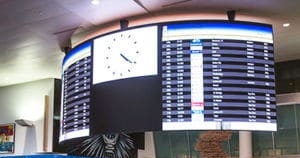Customers often make purchasing decisions based on what they believe to be true rather than what the truth actually is. In the digital display industry, where purchases are large and investments long-term, this bad habit can result in serious disappointment. Hidden costs abound with lower-end display solutions and expectations formed from experience with in-home display products do not always translate to commercial applications. The technology of digital displays is complex, and like any major purchase, it requires greater diligence along the path to purchase than simply trusting preconceived notions.
At Nanolumens, the solutions we provide are the most impressive commercial option on the market. This is evident when looking at any of our award-winning installations, but this reality still bucks against many commonly-held assumptions. For this reason, we focus a good deal of our marketing efforts and advertising resources on educating customers instead of persuading them. We know that if our customers are up to speed on the ins and outs of the industry, they are likely to conclude that working with us is the right move, even if that clashes with what they originally believed. It’s often said that perception is reality, but when your bottom line is on the line, which would you rather trust?
For those as-of-yet unfamiliar with digital displays, it can be tempting to trust your initial perceptions of the technology. Unfortunately, many of these perceptions are wrong. Below, you’ll find several commonly-held assumptions from customers that rarely play out in reality.
Perception: What works in-home also works commercially
Reality: The demands of in-home and commercial display applications can be wildly different, and to advertise their similarity is disingenuous. There are commercial environments where an in-home style display can excel, like a doctor’s waiting room perhaps, but these are usually smaller-scale projects where a standard television could suffice. If your business is thinking big, you need to discard much of what you think you know about display technology. Experience with an LCD television in your living room will have very little overlap with commercial display technology, and finding the right large-format solution for your organization ought to be a thorough process involving diligent self-education.
Perception: The brightness disparity between LED and LCD is negligible in practice
Reality: If this were actually true, why would stadiums and amphitheaters almost exclusively trust LED for their large-format outdoor applications? LED displays are degrees of magnitude brighter than LCD, and are the only display technology powerful enough to contend with high levels of ambient light. In an outdoor environment, or an indoor setting flooded with light like an airport terminal or corporate lobby, LCD displays simply won’t stand out.
Perception: LED is good for distance viewing, but LCD is much better up close
Reality: While LCD has historically been capable of better resolutions and sharper up-close viewing, this advantage is fading fast. The pixel-pitches of LED displays are shrinking rapidly and will soon be highly competitive in environments traditionally dominated by LCD.
Perception: Audiences won’t notice the bezels in an LCD videowall, the images will blend just fine
Reality: Really? Audiences won’t notice thick black cross-hatch lines fragmenting your content? This is like putting an awesome graphic image on a plaid shirt. The image may be fantastic, but the shirt is still plaid, and audiences won’t be able to ignore the lines.
Takeaway: It’s comforting and convenient to approach large-format displays the same way you would an in-home display, but the two have little in common. Dive into the specifics provided by each manufacturer you talk to and double check each assumption you made in the past. In this industry, perception isn’t reality; it only seems like it until you do the research yourself. To learn more about Nanolumens and digital display technology in general, give us a call today!

